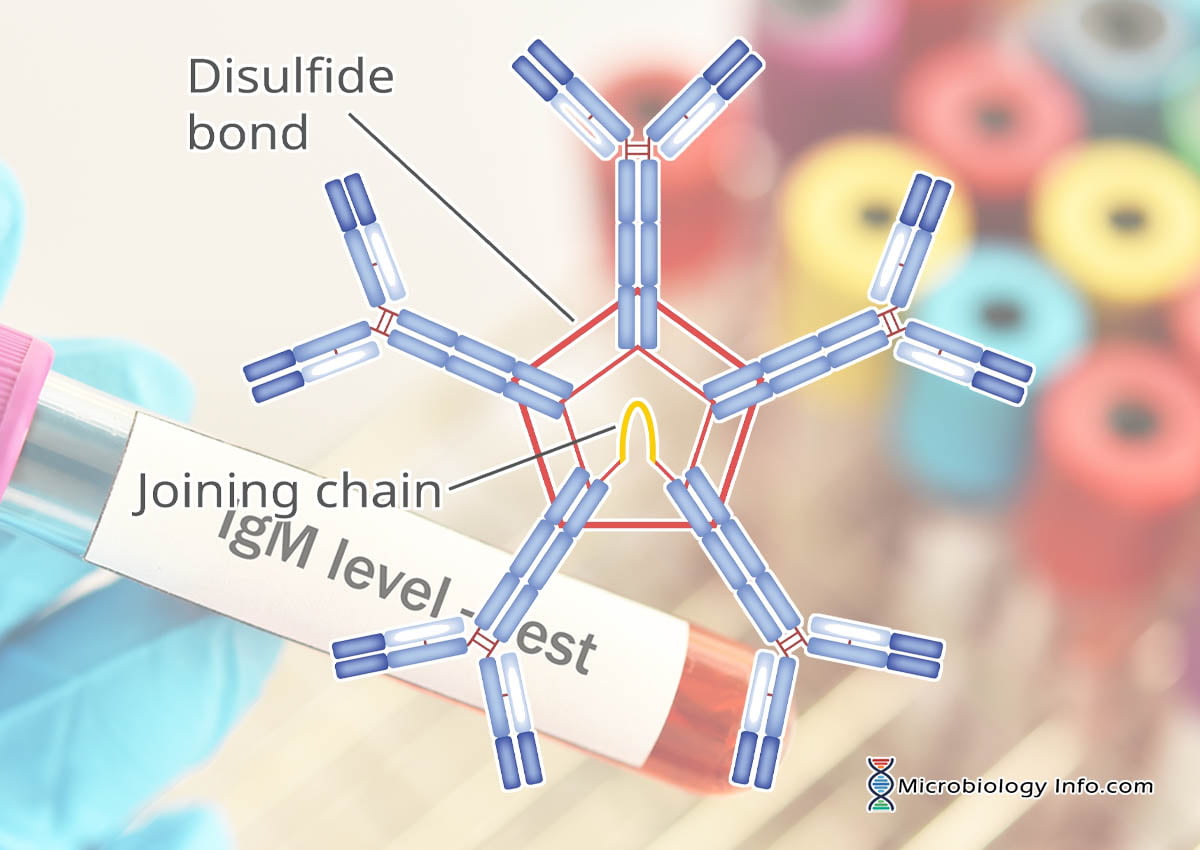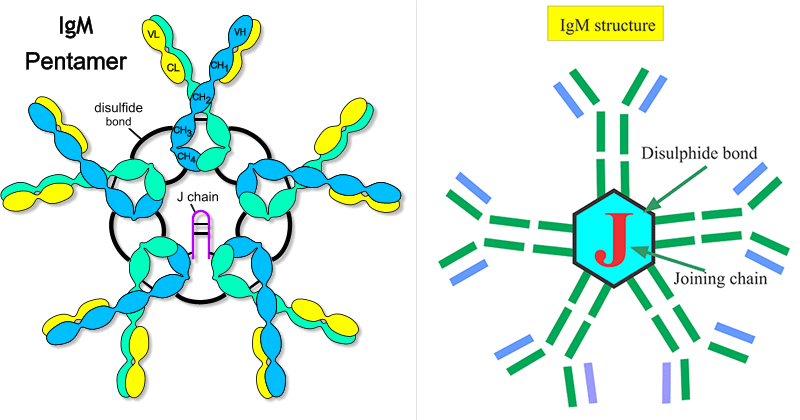- IgA or Immunoglobulin A
- IgD or Immunoglobulin D
- IgE or Immunoglobulin E
- IgG or Immunoglobulin G
- IgM or Immunoglobulin M
Both high and low levels of immunoglobulin in the bloodstream expose the body to plenty of infections and autoimmune disorders.
What Is Immunoglobulins IgM?
IgM is one of the largest antibodies and also the first antibody produced by the body to fight off any new antigens and microbes affecting the immune system.
IgM antibody is also termed as the body’s natural antibody, owing to its ability to latch on to specific antigens without any prior immunization. The IgM antibody is extremely fast in initiating an immune response towards the foreign substance by neutralizing the pathogens directly.
Both elevated levels of IgM and IgM deficiency are bad for health as they seriously compromise the body’s immunity system, exposing it to further infections. For instance, people with IgM deficiency are more prone to fungal infections, recurrent infections, sinusitis, pneumonia, atopic or chronic dermatitis, allergic rhinitis, wheezing and diarrheas’ while elevated levels of IgM antibodies lead to gastrointestinal problems, autoimmune disorders like chronic arthritis, low platelets count, hemolytic anemia, hypothyroidism and kidney disease, neutropenia, risk for some types of cancer like neuroendocrine carcinoma Immunoglobulins M (IgM).
What Is Immunoglobulin M Test?
The Immunoglobulin M Test is used to measure the amount of IgM antibodies in the blood. The IgM test is also used to assess a person’s immune system and also to detect and monitor an excess or deficiency of different Immunoglobulin classes. Immunoglobulins M (IgM) The IgA, IgG, and IgM tests are usually taken together to get a clearer picture of the person’s immunity function and its ability to deal with antigens.
When To Get Tested?
The IgM test is advised if the patient shows the following symptoms;
- Recurrent infections of the respiratory tract like sinusitis, pneumonia
- Infection of the gastrointestinal tract
- IgM deficiency
- Elevated levels of IgM lead to a lack of IgG levels
Immunoglobulin M Test Preparation
The Immunoglobulin M test is a simple blood test and does not require any special preparation. However, it is advisable to inform your doctor about the kind of medication you are taking, as they can affect the IgM test results.
Immunoglobulin M Test Procedure
The Immunoglobulin M test requires a simple blood sample, which is drawn out using an injection from the veins of the forearm.
Immunoglobulin M Test Side Effects
The Immunoglobulin M test is a safe procedure and does not have any risks as such attached to it and whatever side effects that might be are pretty nominal like;
- Soreness of the injection site
- Dizziness
- Excessive bleeding
- Infection at the puncture site
Immunoglobulin M Normal Range
The Immunoglobulin M normal range is variable and depends upon the age of the person. The varied IgM normal range across different age groups are as follows;
- For ages 0- 5 months the IgM normal range is between 26-122 mg/dL
- For 5-9 months the IgM normal range is between 32-132 mg/dL
- For 9-15 months the IgM normal range is between 40-143 mg/dL
- For 15-24 months the IgM normal range is between 46-152 mg/dL
- For 2-4 years the IgM normal range is between 37-184 mg/dL
- For 4-7 years the IgM normal range is between 37-224 mg/dL
- For 7-10 years the IgM normal range is between 38-251 mg/dL
- For 10-13 years the IgM normal range is between 41-255 mg/dL
- For 13-16 years the IgM normal range is between 45-244 mg/dL
- For 16-18 years the IgM normal range is between 49-201 mg/dL
- For over 18 years of age, the IgM normal range is between 37-286 mg/dL
High IgM (>2g/L)
Elevated IgM levels are a nonspecific marker of inflammation, but can be associated with liver disease
Low IgM (<0.5g/L)
Low IgM levels are commonly nonspecific. The significance of this result depends on the clinical presentation and other laboratory parameters.
High IgM (above normal range)
Elevated IgM levels are a nonspecific marker of inflammation, but can be associated with liver disease
Low IgM (below normal range)
Low IgM levels are commonly nonspecific. The significance of this result depends on the clinical presentation and other laboratory parameters
Immunoglobulin M Test Interpretation
The Immunoglobulin M test results are read in terms of high or low. Low IgM levels or IgM deficiency could be due to primary or secondary immune deficiency.
Elevated IgM levels or high IgM levels could be indicative of macroglobulinemia, primary systematic amyloidosis, monoclonal gammopathy, and associated disorders.




[…] standard component of the CBC is the platelet count, which is the number of platelets in your blood sample. In some cases, your doctor may have the […]
[…] are located within the lymph glands and produce antibodies and add them to the blood, which include immunoglobulins and M, G, A, and […]
[…] IgG (most common)(2) IgM (Less common)(2) IgE (Associated with […]
[…] IgM, IgE, IgA, […]
We are a group of volunteers and opening a new scheme in our community. Your web site offered us with valuable information to work on. You’ve done a formidable job and our entire community will be grateful to you.
[…] disorders: Certain types of blood cancers, such as multiple myeloma, Waldenström’s macroglobulinemia, and chronic lymphocytic leukemia, can be linked to […]
[…] of Antibodies are: IgG, IgA,IgM, […]
[…] IgA(b) IgM ✓(c) IgE(d) […]
[…] the urine of individuals with certain types of blood cell disorders, particularly multiple myeloma. Immunoglobulins are antibodies produced by plasma cells, a type of white blood cell. These antibodies consist of […]
[…] Profile test measure the presence of antibodies in form of (IgG or IgM) against a specific group of infectious disease or their level of Concentration in the blood. TORCH […]
[…] antibody tests: These tests look for specific antibodies to EBV, including IgM and IgG antibodies. IgM antibodies usually indicate a recent infection, while IgG antibodies suggest a past infection or […]
[…] IgAB. IgGC. IgMD. […]